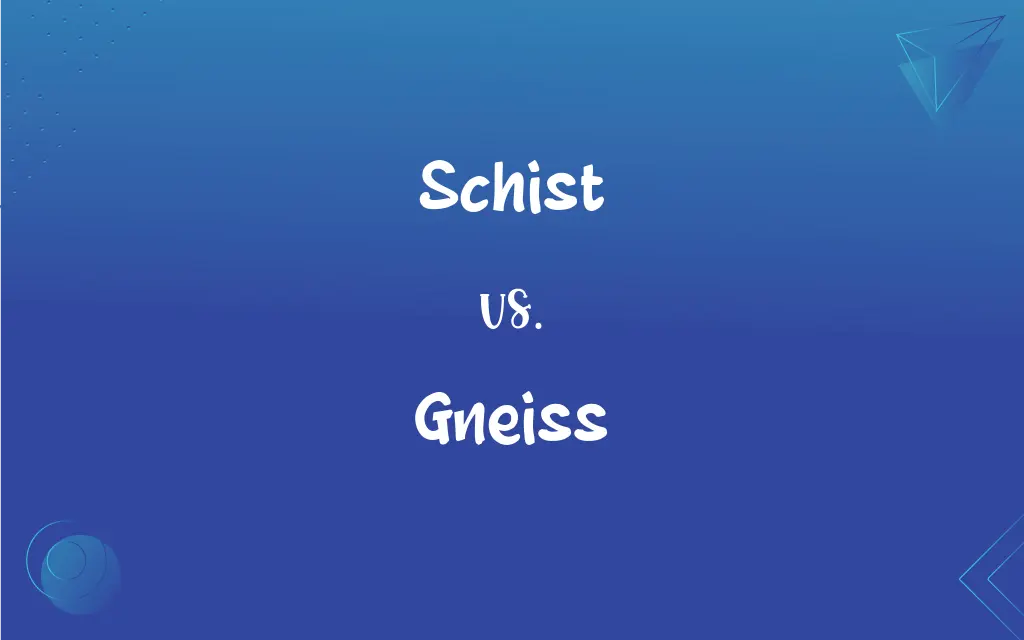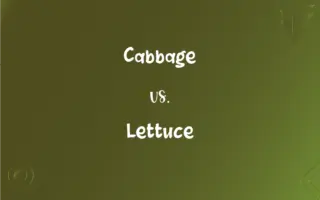Schist vs. Gneiss: What's the Difference?
Edited by Aimie Carlson || By Harlon Moss || Updated on October 16, 2023
Schist is a metamorphic rock with a foliated texture, while gneiss has a more banded appearance.

Key Differences
Schist is a type of metamorphic rock that has been subjected to heat and pressure causing minerals to realign into a foliated texture, where minerals are arranged in layers or bands. Gneiss, on the other hand, is also a metamorphic rock, but has undergone more intense heat and pressure causing it to exhibit distinct light and dark banding patterns.
Schist is predominantly composed of platy minerals like micas, which give it a shiny appearance and allow it to be split into thin layers. Gneiss, conversely, contains a mix of feldspar, quartz, and mica, resulting in a more banded or striped appearance.
The name schist is derived from a Greek word meaning "to split," which references its ability to be split along the mineral layers. In contrast, gneiss is taken from the German word “gneis,” a term used to describe its sparkly appearance.
While both schist and gneiss are products of the metamorphism of a protolith, or original rock, schist is often formed from sedimentary rock like shale, whereas gneiss can form from both sedimentary rocks and igneous rocks like granite.
The degree of metamorphism can be used to distinguish between the two. Schist forms under lower-grade conditions, where temperature and pressure are relatively lower. Gneiss forms under higher-grade conditions, meaning it has been subjected to greater temperature and pressure levels.
ADVERTISEMENT
Comparison Chart
Texture
Foliated (layered appearance)
Banded (distinct light and dark bands)
Main Composition
Platy minerals (mainly micas)
Mix of feldspar, quartz, and mica
Origins of Name
From Greek "to split"
From German “gneis” for sparkly appearance
Typical Protolith (origin)
Sedimentary rock (e.g., shale)
Sedimentary and igneous rocks (e.g., granite)
Degree of Metamorphism
Lower-grade (less heat and pressure)
Higher-grade (more heat and pressure)
ADVERTISEMENT
Schist and Gneiss Definitions
Schist
Originating typically from sedimentary rocks, especially shale.
The transformation from shale to schist is evident in this rock formation.
Gneiss
Comprising minerals like feldspar, quartz, and mica.
The chunk of gneiss had clearly visible quartz in it.
Schist
A metamorphic rock with a foliated texture.
The sunlight reflected off the shiny surface of the schist.
Gneiss
A banded metamorphic rock.
The alternating light and dark bands of the gneiss were mesmerizing.
Schist
A rock predominantly composed of platy minerals, especially micas.
He admired the thin layers of mica within the schist.
Gneiss
Named for its sparkly appearance, from the German “gneis”.
The gneiss shimmered as she held it up to the light.
Schist
A rock that can be split into thin layers due to its mineral alignment.
Craftsmen used schist for roofing because of its splitting ability.
Gneiss
A product of high-grade metamorphism.
The intense banding of the gneiss indicated it had undergone significant changes.
Schist
A product of low to medium-grade metamorphism.
The schist indicated a moderate level of heat and pressure during its formation.
Gneiss
Can be formed from sedimentary or igneous protoliths.
This gneiss evolved from its original state as granite.
Schist
Any of various medium-grained to coarse-grained metamorphic rocks composed of laminated, often flaky parallel layers of chiefly micaceous minerals.
Gneiss
A banded or foliated metamorphic rock, usually of the same composition as granite.
Schist
Any of a variety of coarse-grained crystalline metamorphic rocks with a foliated structure that allows easy division into slabs or slates.
Gneiss
(geology) A common and widely-distributed metamorphic rock having bands or veins, but not schistose.
Schist
Any crystalline rock having a foliated structure (see Foliation) and hence admitting of ready division into slabs or slates. The common kinds are mica schist, and hornblendic schist, consisting chiefly of quartz with mica or hornblende and often feldspar.
Gneiss
A crystalline rock, consisting, like granite, of quartz, feldspar, and mica, but having these materials, especially the mica, arranged in planes, so that it breaks rather easily into coarse slabs or flags. Hornblende sometimes takes the place of the mica, and it is then called hornblendic gneiss or syenitic gneiss. Similar varieties of related rocks are also called gneiss.
Schist
Any metamorphic rock that can be split into thin layers
Gneiss
A laminated metamorphic rock similar to granite
FAQs
What kind of texture does gneiss have?
Gneiss exhibits a distinct banded or striped texture.
What is schist?
Schist is a foliated metamorphic rock mainly composed of platy minerals like micas.
From what kind of rock does schist typically form?
Schist often forms from sedimentary rocks like shale.
What is the origin of the name "gneiss"?
Gneiss is named after the German word “gneis” for its sparkly appearance.
Which rock indicates higher levels of metamorphism, schist or gneiss?
Gneiss indicates higher levels of metamorphism compared to schist.
How is gneiss different from schist?
Gneiss has a banded appearance, while schist has a foliated texture.
Is gneiss harder than schist?
Generally, gneiss is more resistant and less prone to splitting compared to schist.
Can gneiss be used in countertops?
Yes, gneiss can be polished and used for countertops because of its durability.
How can I distinguish between schist and gneiss in hand samples?
Look for the foliated, shiny appearance in schist and the distinct light and dark bands in gneiss.
Which rock, schist or gneiss, is more common in continental crust?
Both are common, but the presence depends on the metamorphic conditions of the region.
What minerals are typical in gneiss?
Feldspar, quartz, and mica are typical minerals found in gneiss.
Is schist suitable for carving?
Due to its ability to split easily, schist can be challenging for detailed carving but is useful for larger, flat designs.
Why is schist named as it is?
The name "schist" is derived from a Greek word meaning "to split."
What are the primary uses of schist?
Schist is used in construction, roofing, and decorative purposes due to its foliated texture.
Why does gneiss have light and dark bands?
The bands result from the segregation of minerals due to high-grade metamorphism.
What is the main composition of schist?
Schist is predominantly made of platy minerals, especially micas.
Can gneiss form from igneous rocks?
Yes, gneiss can form from both sedimentary and igneous rocks.
What gives schist its layered appearance?
The alignment of platy minerals, like micas, gives schist its layered appearance.
Can schist be formed from igneous rocks?
While less common, schist can form from certain igneous rocks under specific conditions.
Can you identify schist by its shiny appearance?
Yes, schist often has a shiny appearance due to its mica content.
About Author
Written by
Harlon MossHarlon is a seasoned quality moderator and accomplished content writer for Difference Wiki. An alumnus of the prestigious University of California, he earned his degree in Computer Science. Leveraging his academic background, Harlon brings a meticulous and informed perspective to his work, ensuring content accuracy and excellence.
Edited by
Aimie CarlsonAimie Carlson, holding a master's degree in English literature, is a fervent English language enthusiast. She lends her writing talents to Difference Wiki, a prominent website that specializes in comparisons, offering readers insightful analyses that both captivate and inform.































































